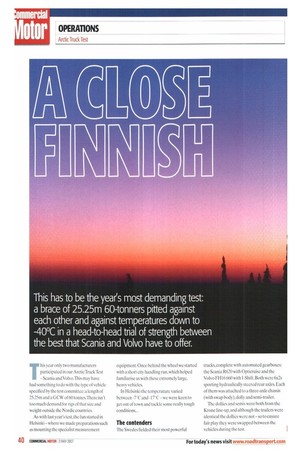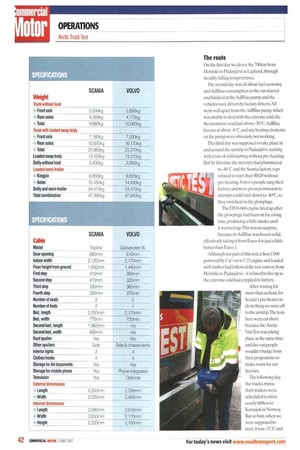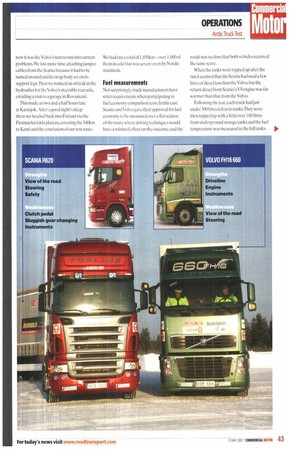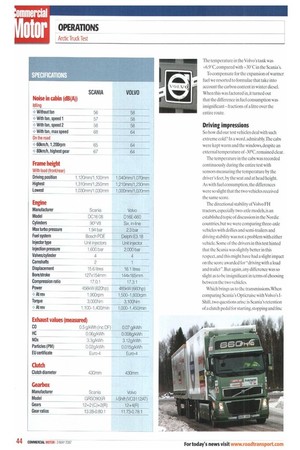This has to be the year's most demanding test: a
Page 40

Page 42

Page 43

Page 44

Page 45

If you've noticed an error in this article please click here to report it so we can fix it.
brace of 25.25m 60-tonners pitLed against each other and against temperatures down to -40°C in a head-to-head trial of strength between the best that Scania and Volvo have to offer.
This year only two manufacturers participated in our ArcticTruck Test —Scania and Volvo.This may have had something to do with the type of vehicle specified by the test committee:a length of 25.25m and a GCW of 60 tonnes.There isn't too much demand for rigs of that size and weight outside the Nordic countries.
As with last year's test, the fun started in Helsinki—where we made preparations such as mounting the specialist measurement equipment. Once behind the wheel we. started with a short city handling run, which helped familiarise us with these extremely large, heavy vehicles.
In Helsinki the temperature varied between -7'C and -17'C—we were keen to get out of town and tackle some really tough conditions...
The contenders
The .Swedes fielded their most powerful trucks, complete with automated gearboxes: the Scania R620 with Opticruise and the Volvo FH16 660 with I-Shift. Both were 6x2s sporting hydraulically steered rear axles. Each of them was attached to a three-axle chassis (with swap body), dolly and semi-trailer.
The dollies and semis were both from the Krone line-up, and although the trailers were identical the dollies were not— so to ensure fair play they were swapped between the vehicles during the test.
The route
On the first day we drove the 7(0km from Helsinki to Pudasjarvi in Lapland, through steadily falling temperatures.
The second day was all about fuel economy and AdBlue consumption so the run started and finished at the AdBlue pump, and the vehicles were driven by factory drivers. All went well apart from the AdBlue pump, which was unable to deal with the extreme cold: the thermometer read just above -30°C,AdB1ue freezes at about -8°C, and any heating elements on the pump were obviously not working.
The third day was supposed to take place in and around the airstrip in Pudasjarvi, starting with a test of cold starting without pre-heating. But by this time the mercury had plummeted to -40°C and the Scania factory reps refused to start their R620 without pre-heating.Volvo's people rang their factory and were given permission to attempt a cold start down to -40"C, so they switched on the glowplugs.
The FH16 660 engine tired up after the glowplugs had been on for a long time, producing a little smoke until it warmed up.This was no surprise because its AdBlue was frozen solid, effectively taking it from Euro-4 to just a little better than Euro-1.
Although not part of this test, a Sisu C600 powered by Cat's new C15 engine and loaded with timber had followed the test convoy from Helsinki to Pudasjarvi it refused to fire up as the extreme cold had crippled its battery.
After waiting for more than an hour for Scania's pre-heater to do its thing we were off to the airstrip.The tests here were cut short because the Arctic Van Test was taking place at the same time and the van people wouldn't budge from their programme to make room for our heavies.
The following day the trucks, minus their trailers, were scheduled to drive nearly 600km to Karasjok in Norway. But at 8am, when we were supposed to start, it was -32'C and now it was the Volvo's turn to run into current problems. We lost more time attaching jumper cables from the Scania because it had to be turned around and its swap body set on its support legs.`lben we noticed an oil leak in the hydraulics for the Volvo's steerahle rear axle, entailing a visit to a garage in Rovaniemi.
This made us two and a half hours late at Karasjok. After a good night's sleep there we headed back into Finland via the Firmmarksvidda plateau, covering the 540km to kerni and the conclusion of our test route. We had run a total of 1,850km—over 1,000 of them in cold that was severe even by Nordic standards.
Fuel measurements Not surprising1y. truck manufacturers have strict requirements when participating in fuel economy comparison tests. In this case Scania and Volvo gave their approval for fuel economy to he measured over a flat section of the route where driving techniques would have a minimal effect on the outcome, and the
result was so close that both vehicles received the same score.
When the tanks were topped up after the run it seemed that the Scania had used a few litres of diesel less than the Volvo, but the return diesel from Scania's V8 engine was far warmer than that from the Volvo.
Following the test, each truck had just under 3(X) litres left in its tanks.They were then topped up with a little over 100 litres from underground storage tanks and the fuel temperature was measured in the full tanks.
The temperature in the Volvo's tank was +6.9°C, compared with +30'C in the Scania's.
To compensate for the expansion of warmer fuel we resorted to formulae that take into account the carbon content in winter diesel. When this was factored in, it turned out that the difference in fuel consumption was insignificant fractions of a litre over the entire route.
Driving impressions So how did our test vehicles deal with such extreme cold? In a word, admirably.The cabs were kept warm and the windows, despite an external temperature of -30'C, remained clear.
The temperature in the cabs was recorded continuously during the entire test with sensors measuring the temperature by the driver's feet, by the seat and at head height. As with fuel consumption, the differences were so slight that the two vehicles received the same score.
The directional stability of Volvo FH tractors, especially two-axle models, is an established topic of discussion in the Nordic countries, but we were comparing three-axle vehicles with dollies and semi-trailers and driving stability was not a problem with either vehicle. Some of the drivers in this test hinted that the Scania was slightly better in this respect, and this might have had a slight impact on the score awarded for driving with a load and trailer". But again, any difference was so slight as to be insignificant in terms of choosing between the two vehicles.
Which brings us to the transmissions.When comparing Scania's Opticruise with Volvo's IShift, two questions arise: is Scania's retention of a clutch pedal for starting, stopping and line manoeuvring an advantage or a disadvantage? And does it matter that the Opticruise system takes longer to change gears?
As for the clutch, the test drivers thought it was unnecessary and somewhat of an inconvenience.When you are driving with an automated box, they say, you should not have to risk stalling the engine when stopping because you forgot the clutch.And starting, stopping and fine manoeuvring with Volvo's I-Shift is just as easy without a clutch pedal.
The Scania's slower gear changing did not attract any strong criticism, but the Volvo 1-Shift was praised for its quickness and perfect gear changing.lhis quickness yields an advantage every time the vehicle needs to be accelerated from a standstill to cruising speed, and is also beneficial when pulling away or changing down on an ascent.
The 25.25m rigs did not worry our test drivers, all of whom had some experience of this class of vehicle from previous test drives in Sweden. Everyone who has tried them knows these rigs need only marginally more space than a conventional artic on turns and at intersections.
Conclusion
We believe the Volvo FH16's electrical problems were man-made', as were its hydraulic problems which were due to defects in assembly. As one-offs they were not counted against it.
Both vehicles passed this low-temperature test with flying colours, and the refilling of AdBlue showed that both heating systems were able to keep the AdBlue from freezing while driving in temperatures that fell as low as -WC.
Both vehicles scored highly. Volvo does have longer service intervals than Scania, and taking this into account makes up for the tiny tenths-of-a-point difference in Scania's favour. So while each vehicle has its strengths, the total points awarded were so close that the only fair decision is a draw. •


























































































































































































